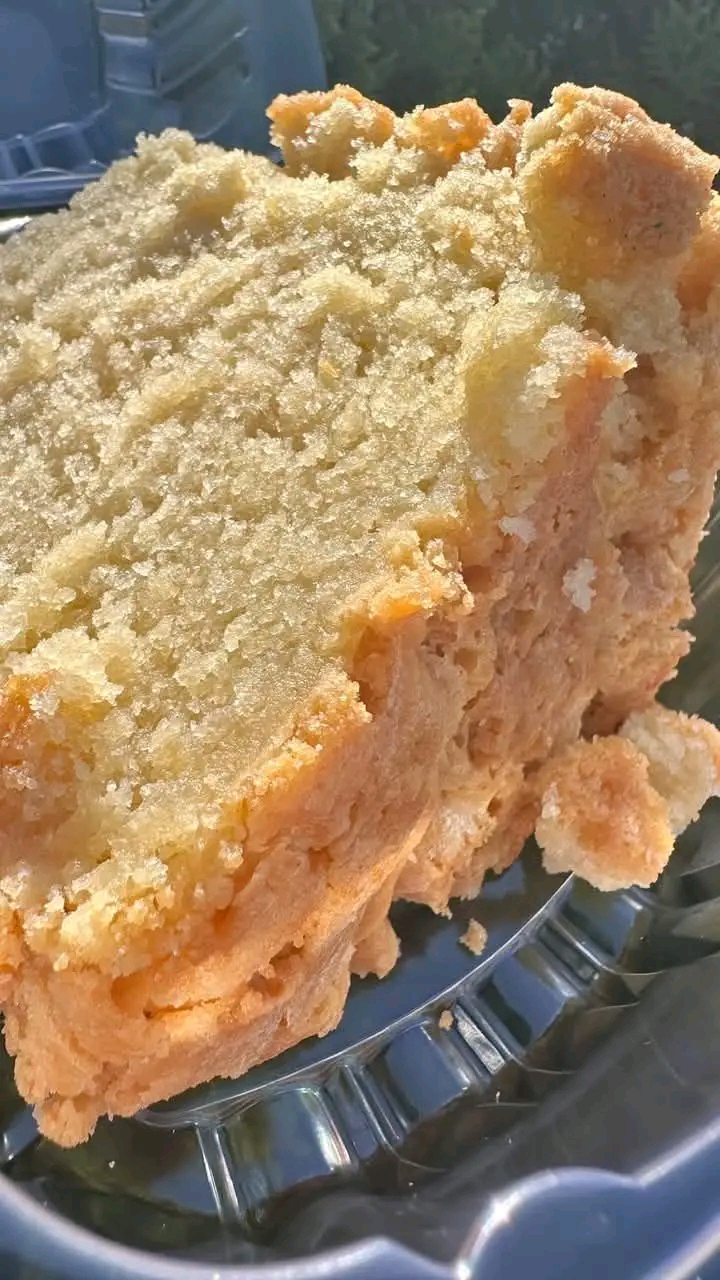Absolutely! That golden, crunchy crust on a sour cream pound cake is pure joy—like a cookie married a cake and made something magical. Below is a grand, rich, and deep dive into the world of Sour Cream Pound Cake, crafted for lovers of the crust, the crumb, and the tradition.
The Legendary Sour Cream Pound Cake
Introduction:
The sour cream pound cake is a Southern treasure, deeply rooted in the warmth of home kitchens where time slows and butter sings. Its crisp, golden-brown crust whispers of caramelization, while the inside stays rich and moist from the fat and tang of sour cream. With no glaze to interfere, the flavors stand proud: butter, vanilla, eggs, and sugar in divine harmony.
This cake isn’t just food—it’s memory, comfort, family reunions, Sunday suppers, and late-night cravings. You eat it with your hands, your heart, and your smile.
History:
The pound cake traces back to 18th-century Europe. Originally named for its simple ratio—a pound each of butter, sugar, flour, and eggs—this cake has traveled through time and continents. In the American South, the recipe evolved, adopting sour cream for extra moisture, and often skipping leaveners like baking powder for a denser crumb and richer bite. Its crusty bottom became a secret delicacy: a caramelized surprise for those who know to flip it over and love from the base up.
Ingredients (makes one glorious full-size bundt cake):
- 1 cup (226g) unsalted butter, room temperature
- 3 cups (600g) granulated sugar
- 6 large eggs, room temperature
- 3 cups (360g) all-purpose flour, sifted
- 1/4 tsp baking soda (just enough to aid lift without ruining density)
- 1/2 tsp salt
- 1 cup (240g) full-fat sour cream, room temperature
- 1 tbsp pure vanilla extract
- Optional: 1/2 tsp almond extract for complexity
Equipment:
- Stand mixer or hand mixer
- 12-cup Bundt pan or tube pan (well-greased and floured)
- Sifter
- Rubber spatula
- Wire rack
Instructions & Methodology (The Art of the Crust):
1. Prepare Your Pan
Grease the pan with butter or shortening, then dust generously with flour, tapping out the excess. Don’t skimp—this crust is where the cookie-like edges begin.
2. Cream Butter & Sugar (10 Minutes of Glory)
In a large mixing bowl, beat the butter on medium speed for 2–3 minutes until light and fluffy. Slowly add the sugar, one cup at a time, beating continuously for at least 8 minutes. This step develops the air structure. The mixture should look pale, fluffy, and dreamy.
3. Add Eggs, One at a Time
Crack each egg into a small bowl and add one by one to the mixer, beating well between additions. Scrape down the sides. This keeps the batter silky and cohesive.
4. Mix Dry Ingredients Separately
In another bowl, sift together the flour, baking soda, and salt. This prevents clumping and distributes the leavening gently.
5. Alternate Dry and Sour Cream
With the mixer on low, add the flour mixture in thirds, alternating with the sour cream (starting and ending with flour). Mix just until combined each time. Do not overmix—you want a tender crumb.
6. Add Flavorings
Pour in the vanilla (and almond, if using). Mix briefly to incorporate.
7. Pour into Pan Like You Mean It
Spoon the thick, luscious batter into the prepared pan. Use a spatula to smooth the top. Tap the pan on the counter 2–3 times to release air bubbles.
8. Bake Low and Slow
Place in a cold oven (yes, cold) and set it to 325°F (163°C). Bake for 1 hour 15 minutes to 1 hour 30 minutes, depending on your oven. Check at 70 minutes. A toothpick should come out with a few moist crumbs—not wet batter.
9. Cool Like a Southern Breeze
Let cool in the pan for 15–20 minutes. Invert onto a wire rack and cool completely. This pause allows the crunchy crust to set and hold.
Formation of the Crust:
The crunchy bottom forms from a balance of sugar, fat, slow baking, and generous pan greasing. Sugar in contact with the metal caramelizes while butter keeps it golden and crispy. Starting in a cold oven gives the cake time to rise and the crust time to develop evenly.
Serving & Loving:
Serve plain. No glaze. No frosting. No distractions. Let the crust speak, the crumb hum.
Lovers of the Cake say:
- “It’s like the top of a muffin, but better.”
- “I hide the bottom for myself—it’s the best part.”
- “I toasted a slice and it was heaven on earth.”
Optional Enhancements:
- Toasted slice with a pat of butter.
- Served warm with berries and cream.
- Dusted with powdered sugar for aesthetic charm.
Conclusion:
Sour cream pound cake is more than dessert—it’s a ritual. The crunch of the crust, the moisture of the crumb, the simplicity of its elegance. Each slice is an ode to heritage, patience, and the small joys of the kitchen.
Whether you’re a crust lover, a crumb aficionado, or a cake romantic, this one’s for you.
Would you like a printable recipe card or a visual diagram of the process?
